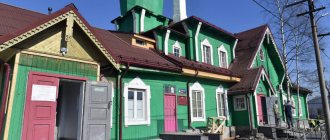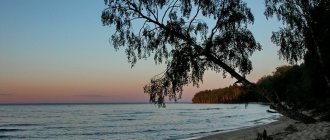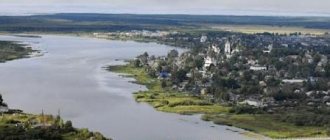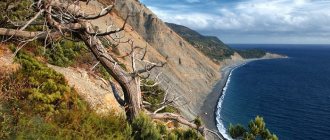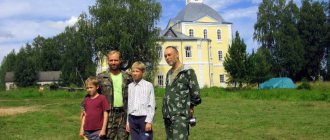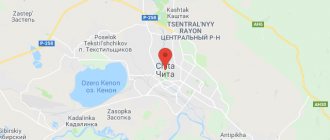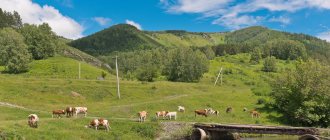Sestroretsk is located in the Kurortny district of St. Petersburg, at the mouth of the Sestra River between the Gulf of Finland and Lake Razliv. The well-known balneological and mud clinic is located here, but other attractions of Sestroretsk are of no less interest.
And even though not as much is known about this place as about other suburbs of St. Petersburg. The cleanest air, sandy beaches, pine forests, wide alleys of parks and squares, the waters of the bay shimmering in the sun - all this annually attracts a huge number of tourists.
Anna Akhmatova, Leonid Andreev, Mikhail Zoshchenko, Korney Chukovsky once worked in this paradise, and Sasha Cherny and Igor Severyanin performed on the stages of local theaters and cultural centers. Today we will talk about how Sestroretsk came into being, what it is like now, and what interesting city places are worth visiting first.
The city of Sestroretsk: history and modernity
Lake Razliv
Sestroretsk owes its foundation to the reformer Tsar Peter the Great, who was struck not only by the amazing local beauty, but also by the convenient strategic location to the line of battle with the Swedish army. In 1714, on his orders, weapons factories began to be built here, a wooden royal palace was erected (dismantled at the end of the 18th century after it was severely damaged by a storm) and a park was laid out, which has survived to this day.
Sister River
Arms factories, where production began in the early 1720s, worked for the benefit of the Russian Empire - they produced cannons, muskets, pistols, gunpowder - throughout almost the entire 18th century. Today you can find several abandoned fortifications here; there are many who want to risk their health in attempts to study them on their own.
At the end of the 19th century, the creation of a resort with its own mineral springs began in Sestroretsk, and at the turn of the 19th-20th centuries the balneological sanatorium “Sestroretsk Resort” was opened here - it became the largest health center on the entire coast of the Gulf of Finland. In the 20s, its profile was defined as cardiological - people with heart and vascular diseases received medical procedures here.
The Gulf of Finland
During the first quarter of 1924, about one and a half thousand people rested and recovered here. Shortly before the start of the war, the institution was transferred to the People's Commissariat of Defense of the USSR. In 1925, Sestroretsk became a full-fledged city.
During difficult war times, the front line passed near Sestroretsk. In the fall of 1941, Finnish troops stopped their offensive near these places. The Sestroretsk defense line passed here, from which in the summer of 1944 the Red Army troops launched a counteroffensive.
Unfortunately, the main building of the Sestroretsk Resort did not survive the war, and the new medical building of the sanatorium opened only in the mid-50s. After the end of the Second World War and during the heyday of the USSR, Sestroretsk began to be massively built up with new multi-storey residential buildings, and the population grew 17 times - from 2,415 people in 1945 to 41,160 people in 2022. The Belneological resorts of this city attract older people, young people, and families with children, and the local beaches are actively used by fans of such extreme sports as kitesurfing.
Today Sestroretsk is developing rapidly - new infrastructure and social facilities are appearing. Residents of the city work not only in sanatoriums and boarding houses - there is an automobile plant, a bakery, a clothing factory and many other smaller enterprises here.
Monument Two Sisters
Already in our days, such sights of Sestroretsk as the monument to Peter the Great, the monument to the inventor of the rifle S.I. Mosin, Church of Saints Equal-to-the-Apostles Peter and Paul. And also the only swimming pool filled with mineral water in St. Petersburg and its surroundings. In addition, in 2011, the state reserve “Sestroretskoe Bog” was established on the territory of Sestroretsk.
Ancient dachas in Sestroretsk
At all times, people, tired of the bustle of big cities, dreamed of seclusion in the bosom of nature. That is why in provinces like Sestroretsk there are many estates - houses where noble families spent quiet days away from the noise of capital St. Petersburg.
Dacha Goldenova
- Address: st. Maxim Gorky, 20.
Yakov Mikhailovich Goldenov is a Russian writer of the 19th-20th centuries. In 1908, he hired the architect Sergei Ginter to build a country dacha for his family. The log building, hidden in the middle of a coniferous forest, became a cozy family nest and served as a home for Goldenov’s heirs before the revolution.
In 1970, the Sestroretsk holiday home settled in the estate, which operated for many years. The building gradually fell into disrepair, and a fire in 2009 seriously damaged its structure. The ruins of the house were demolished, and in their place a new building was built - a copy of the ancient estate, which today is recognized as an object of regional significance.
Dvorzhetsky's dacha
- Address: Oranzhereynaya st., 3.
Another creation of Sergei Ginter belonged to the notary S.I. Dvorzhetsky. This is a wooden manor with an attic, built in the Art Nouveau style at the end of the 19th century. Despite its age, the house has retained its delights: rectangular windows with small glazing, semi-columns and carved decorations.
After Dvorzhetsky's death in 1913, the dacha changed owners several times. For some time, the famous opera singer L.V. Sobinov lived there. Today, the building of this attraction is recognized as an object of historical and cultural heritage and is in good condition.
Dubki Park
The city park "Dubki" on the shore of the Gulf of Finland has existed since the times of Peter the Great. During the reign of Peter, land was brought here to plant several thousand young oak trees. A little later, a royal palace was built, a protective dam was built, and rows of fruit trees were planted. The Emperor loved to take a break here from government affairs, campaigns and travel. During his time there was a Dutch garden, a vegetable garden, ponds, and galleries.
The park has survived to this day and was completely reconstructed in the middle of the 20th century. Today it is the center of cultural and sports life in Sestroretsk. There is a hippodrome, a stadium with two football fields, tennis courts and a gym.
Children will love the Glade of Fairy Tales and the playground. Adults can go up to the observation deck at Cape Dubovsky. The paths and alleys of the park are well-maintained, an ice skating rink operates here on a permanent basis in winter, and various competitions and festivals are held year-round.
Natural attractions in the vicinity of Sestroretsk
Sestroretsk is literally surrounded by greenery and is a wonderful eco-tourism destination. If you like hiking and traveling through virgin lands, then this city will not disappoint you.
Ecological trail “Komarovsky Coast”
- Address: Komarovo village.
The Komarovsky Coast is called an open-air nature museum. An ecological trail is a set of paths passing through the thick of a coniferous forest. Along the way, tourists encounter centuries-old trees, huge anthills, and forest inhabitants (squirrels, hares, chipmunks). Along the wooden boardwalks along which a group of travelers follows, there are stands with educational facts about the fauna and flora of this natural area.
It is not recommended to leave the marked trail. The area is full of ravines, bogs and rushing streams. In addition, it is easy to get lost in the pine forest.
A walk along the ecological trail has a healing effect. Fresh air, saturated with the smell of herbs, pine needles and resin, has a beneficial effect on physical and mental well-being. This hike is especially recommended for people who have suffered from lung and respiratory diseases. “Komarovsky Bereg” is a stunning place that can give you an unforgettable weekend in nature.
Forest Park "Sestroretskoe Bog"
- GPS coordinates: 60.111211, 30.025416.
To the northeast of the center of Sestroretsk there is this unique natural park, well-equipped for visiting even with small children. As reviews say, the combination of forest and swampy terrain here is very harmonious - the views are truly unforgettable. Wooden paths are laid over the viscous swamp, thanks to which new routes open up for lovers of hiking in the fresh air.
Monument to Peter the Great
The monument to Peter the Great in Dubki Park depicts the autocrat in a completely unusual form for us - in a sitting position and without a headdress, he is wearing a simple shirt, an ax in one hand, and a board in the other. The monumental structure was installed here in 2014, when Sestroretsk celebrated its 300th anniversary. The basis for it was a similar monument to Peter, destroyed by a flood.
Lenin's hut
Shalash V.I. Lenin in Razliv is perhaps the most famous landmark of Sestroretsk. Information about it is in every city guide; every tourist wants to see it. After all, it was in Sestroretsk and its environs that the leader of the world proletariat, together with the revolutionary G.E. Zinoviev was hiding from persecution by the Provisional Government.
During the Soviet years, Zinoviev was not mentioned in Razliv, due to his being declared an enemy of the people and his execution in 1936.
Granite hut by architect A.I. Hegello
The “Shalash” monument, made of granite, was opened in Sestroretsk in 1928. There is a memorial inscription carved on it, and not far from it there is a museum, by visiting which, guests of the city will get acquainted with the life and activities of the Bolshevik leader.
Beaches of Sestroretsk
No seaside resort can be imagined without beaches. There are plenty of them in Sestroretsk. These are Wonderful, Affectionate, Officer, Children's and other sandy beaches.
The most popular beach in the Sestroretsk resort area is called Laskovy. It is located north of the town itself. The beach is clean and well maintained, there are changing rooms, toilets, changing cabins and children's playgrounds. In addition, it offers a wonderful view of the Gulf of Finland.
Memorial "Sister"
The “Sister” memorial is located on the 38th kilometer of Primorskoe Highway and is an integral part of the “Green Belt of Glory of Leningrad”. During the Great Patriotic War, large-scale military operations took place at 38 and 39 km of the highway, and this memorial structure does not allow descendants to forget about those tragic events.
Along with the “Sister” memorial, the “Green Belt of Glory of Leningrad” also includes other sights of Sestroretsk - for example, the “White Belt” and the birch alley, which runs exactly along the line of defense.
Where to go for a walk in Sestroretsk
Sestroretsk is a well-groomed and comfortable city. Walking through its parks, squares and coastline is a pleasure.
Petrovskaya embankment
Initially, the embankment was a single walking area with a length of 460 m, but in the 1970s. Primorskoye Highway was built, dividing it into two parts. The embankment got its name in honor of Peter I. Two centuries ago, his wooden palace stood here. Peter loved the sea and preferred to build his houses as close to it as possible.
To this day, the imperial palace has not been preserved, and the development of the seaside promenade is mainly made up of the Peter and Paul Church. Petrovskaya Embankment is popular among city residents due to its landscaped walking terraces and beautiful views of Sestroretsky Razliv.
Peter the Great Square
- GPS coordinates: 60.092289, 29.973978.
Another picturesque place named after the legendary emperor is located near Freedom Square.
Peter the Great Square is a cozy corner of nature. Here, well-groomed lawns are green, aspen leaves are rustling and flower beds are fragrant. Narrow paths connect in the center of the site, where a bronze bust of Peter I is installed.
Couples with children like to spend time in the quiet park, and photo sessions are also held here against the backdrop of nature.
Cathedral of Peter and Paul
The snow-white Church of Peter and Paul with gilded domes was originally built of wood - this happened simultaneously with the construction of the palace and the design of the park. However, it burned down 5 years after Peter’s death, and a new stone church was built in its place. It existed for two centuries, but in 1931 a decision was made to close it.
It must be said that just a few years before these events it received the status of a cathedral, but, apparently, the persecution of religion and the church could not pass by. As a result, over the next two years, the Peter and Paul Church was dismantled to its foundations, and an educational institution was built in its place.
Only at the turn of the 20th and 21st centuries did the authorities decide to rebuild the temple in Sestroretsk. Construction work lasted 11 long years, and the first service in the newly rebuilt structure took place in 2009. Today, the Peter and Paul Cathedral regularly receives parishioners and guests.
Sestroretsk temples and churches
In addition to religious and educational activities, the churches of Sestroretsk perform another function - they serve as monuments to history and religious architecture of different eras.
Temple of the Holy Great Martyr and Healer Panteleimon
- Address: Tarkhovsky Avenue, 32.
Panteleimon Church was built at the beginning of the 20th century. It resembled a wooden tower from a fairy tale. This effect was created by bright colors and sloping roofs with lace cornices.
A double staircase with canopies supported by narrow columns led to the front porch. A tented bell tower topped with a gilded dome rose above the main building. The church existed until 1937. Then she was beheaded, the bells and domes were melted down, and the rector of the church was arrested and taken to prison in his cassock.
The headquarters of the NKVD was located in the building of the former temple, and the court functioned. Criminals sentenced to death were shot in the backyard, and then they were buried in mass graves in the church cemetery.
During the Siege of Leningrad, convicts had it even worse: they were not given a quick death, but were left to die in cold rooms from hunger. And their bodies were thrown in the street, unburied. After the end of the war, the building was given to the fire department, and the bell tower was converted into an observation tower.
The revival of the church took place in the winter of 1990. The building was restored and returned to its original appearance. The backyard wall where the executions took place is considered a memorial. Flowers are laid at its base and candles are lit.
Chapel of St. Nicholas the Wonderworker
- Address: Perepadskaya embankment, 2.
The chapel was erected in the early 2000s in honor of Russian submariners killed in battle. We are talking about a small log structure with a tiled dome and a white stone belfry. At the base of the building there is a capsule filled with soil from the cities where submarines were based during the Second World War, and inside the building there are boards with the names of lost submarines. The chapel stands on the picturesque shore of Lake Sestroretsky Razliv, surrounded by deciduous trees.
Ostap Bender Museum
The Ostap Bender Museum was opened in the mid-90s of the last century. Here you can learn about the prototypes of the heroes of the immortal works of I. Ilf and E. Petrov, see the cap of the “great schemer”, Panikovsky’s weight, famous chairs and other objects from the novels “The Twelve Chairs” and “The Golden Calf”.
Exhibits were collected in a variety of places - in pawn shops, antiques stores, and even just on the street. A distinctive feature of the museum is that all the exhibited items can not only be seen, but also held in your hands.
Novikov's dacha
The mysterious dilapidated building on Ispolkomskaya Street is the former estate of the provincial secretary I.I. Novikov. After the owner disappeared without a trace in 1917, the building changed several owners, and various organizations were located here. Since the 90s, the once beautiful building has been in disrepair, gradually being destroyed, but increasingly attracting lovers of mysticism and thrills.
Emelyanov's barn
This nondescript wooden barn, preserved from pre-revolutionary times, is located on Emelyanova Street, 3. In the summer of 1917, this was the site of Vladimir Ilyich Lenin’s underground refuge. In the attic of this barn he hid from the police of the Russian Provisional Government, but then was forced to move to a hut on the shore of the Sestroretsk spill (later a monument was erected on the site of the hut).
In 1925, the building was turned into a museum. Previously, Nikolai Emelyanov’s barn was an important pilgrimage point for Soviet tourists. Endless lines of excursion buses pulled towards it both in summer and winter. Currently, the historical building is covered with a glass cover. The museum is open daily (except Wednesdays) from 11:00 to 19:00.
Monument to the first submarine
Getting to this landmark of Sestroretsk is not difficult - it is located not far from the Peter and Paul Cathedral and is especially interesting for children. It is known that the prototype of the first submarine was built during the reign of Emperor Peter by a certain Efim Nikonov - outwardly it was an ordinary wooden barrel equipped with a periscope. The modern monument is an exact copy of this “miracle of engineering.”
Sestroretsk gazebo
A copy of the Sestroretsk gazebo on Tokarev Street, building 1
For a long time, this object in the Resort was considered a symbol of Sestroretsk, its image was placed on postcards. People called the gazebo Shalyapinskaya - residents believed that this was a kind of stage intended for the great artist. Although, according to experts, there is not a single confirmation that Fyodor Chaliapin ever visited these places.
The gazebo was made and decorated by skilled wood carvers, but, unfortunately, it has not survived to this day. Today the object is in ruins, and at the opposite end of the city there is an exact copy of it.
"Petrovsky Arsenal"
The territory of the former Sestroretsk arms factory is now being actively reconstructed and transformed, gradually turning into a recreational area. In the near future, the Petrovsky Arsenal should become a popular attraction in Sestroretsk and the Leningrad region.
“Petrovsky Arsenal” is planned as a new cultural space for residents and guests of the city. Here, on an area of 14 hectares, there is already a summer cinema, football and volleyball courts, galleries and art objects, cafes, libraries and bicycle parking. During the reconstruction of the area, the buildings and historical layout of the old plant are preserved.

